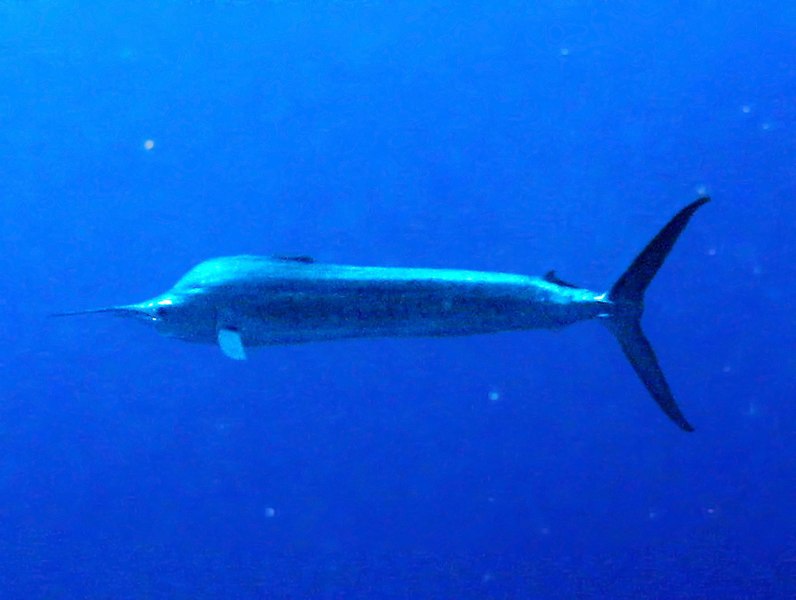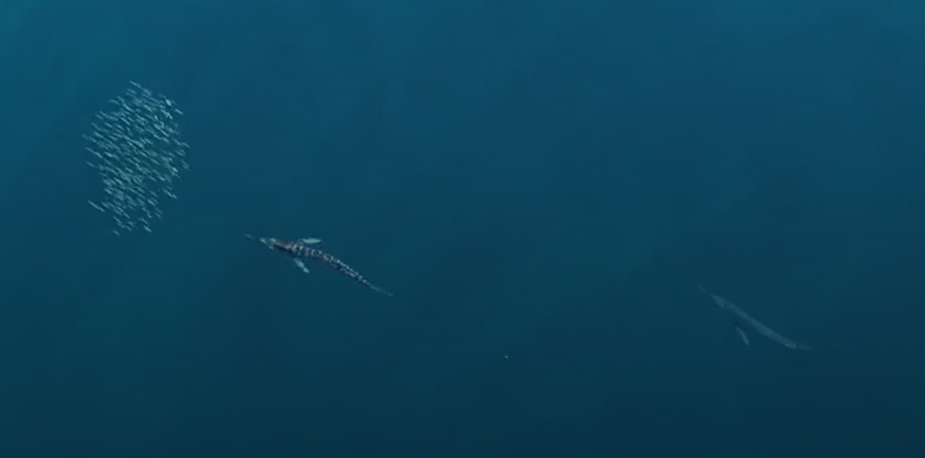The Fish That Glow … As a Warning?
Blue marlins, like the one pictured above, are commonly found in both the Atlantic and Pacific Oceans. Adults typically measure about 3.5 meters (11 feet) long and can reach lengths of 5 meters (16 feet), but despite their size, they’re still very fast — among the fastest animals in the water, and comparable to the fastest on land and in the air as well. They are fish that eat other fish, using their long, pointy bills as weapons. As Wikipedia’s editors explain, “it uses its bill to stun, injure, or kill while knifing through a school of fish or other prey, then returns to eat the injured or stunned fish.”
And that’s great (if you’re a marlin, not if your its prey) when a hungry marlin is off by itself. But marlins, like other fish, rarely travel alone. Hunting in packs, though, can be dangerous — if multiple marlins attack a school of fish at the same time, there’s a decent chance that the marlins will accidentally stab one another.
How do they avoid this? According to one recent study, they may flash each other signals — by changing the design on their skin.
It’s not very easy to see in the image above but marlins, naturally, have stripes. Here’s a screenshot from a video of a few marlins attacking a school of sardines, and the stripes in the lead marlin are quite prominent — you could even say they glow.
And “glow” is a fair description. As the Telegraph explains, marlins have “two chromatophores in its skin which can change color when signaled by its nervous system. It is thought that one of the pigments overlies the other in bands and exposes the glowing bright blue bands when activated.” But until recently, the science community didn’t have a great explanation of when marlins used that ability, or why.
In early 2024, a team of researchers led by Alicia Burns of Humboldt University in Berlin, Germany published a paper (here if you’re interested, but I’m going to summarize!) sharing their findings. The team was able to use drone footage to capture marlins attacking sardines — that’s where the screenshot above comes from. Science magazine has a 28-second version of the video, which you can — and should! — watch here. What is happening is very clear: right before the first marlin attacks the fish, its stripes begin to glow. When the attack is over, the stripes fade and another marlin takes its stab at the school — and as that second marlin approaches its prey, its stripes begin to glow. As Science notes, “the display only occurred during hunting, suggesting it’s a signal to the other blitzing marlin to stay back.”
At least, that’s the team’s prevailing theory — for now. Alternatively, Burns told the Telegraph, the stripe flashing may be a way to confuse the prey or mask the attacking fish as something less dangerous, and more research is needed to help us understand the behavior. But regardless, if you’re swimming near marlins and you see one flashing its stripes, get out of its way!
Bonus fact: Marlins are game fish whose numbers are at risk due to overfishing of their prey, and as a result, you typically need a license if you want to go marlin fishing. In 2010, that proved to be a costly mistake for a fisherman named Andy Thomossan. He and his fishing crew entered a fishing competition and caught a 883-pound marlin, the largest marlin catch on record. The prize for such a catch was nearly $1 million, but unfortunately, Thomossan never saw a dime. As NBC News explained, the rules of the competition required that “all individuals [on the boat] had to have a valid state fishing license,” even if they weren’t engaged in the actual “fishing” part of the journey. The first mate that Thomassan hired, Peter Wann, never operated any fishing equipment, but it didn’t matter — he needed a license and his was long expired. Per NBC News, upon discovering this, “Wann renewed it wirelessly and hoped for the best. That was at 5:51 p.m. The team had reeled in the fish at 3:16 p.m. Eight days, two lie detector tests, and hours of scrutiny and agonizing deliberation later, tournament officials made their decision. They would not be awarding the prize to Wann and his teammates from the boat Citation.” The cost of the license? $30.
From the Archives: The Bright Orange Man Behind the Plate: A different kind of marlin.


